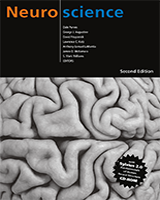By agreement with the publisher, this book is accessible by the search feature, but cannot be browsed.
NCBI Bookshelf. A service of the National Library of Medicine, National Institutes of Health.
Purves D, Augustine GJ, Fitzpatrick D, et al., editors. Neuroscience. 2nd edition. Sunderland (MA): Sinauer Associates; 2001.

Neuroscience. 2nd edition.
Show detailsThe action potentials generated by tactile and other mechanosensory stimuli are transmitted to the spinal cord by afferent sensory axons traveling in the peripheral nerves. The neuronal cell bodies that give rise to these first-order axons are located in the dorsal root (or sensory) ganglia associated with each segmental spinal nerve (see Figure 9.1 and Box C). Dorsal root ganglion cells are also known as first-order neurons because they initiate the sensory process. The ganglion cells thus give rise to long peripheral axons that end in the somatic receptor specializations already described, and shorter central axons that reach the dorsolateral region of the spinal cord via the dorsal (sensory) roots of each spinal cord segment. The large myelinated fibers that innervate low-threshold mechanoreceptors are derived from the largest neurons in these ganglia, whereas the smaller ganglion cells give rise to smaller afferent nerve fibers that end in the high-threshold nociceptors and thermoceptors (see Table 9.1).
Box C
Dermatomes.
Depending on whether they belong to the mechanosensory system or to the pain and temperature system, the first-order axons carrying information from somatic receptors have different patterns of termination in the spinal cord and define distinct somatic sensory pathways within the central nervous system (see Figure 9.1). The dorsal column-medial lemniscus pathway carries the majority of information from the mechanoreceptors that mediate tactile discrimination and proprioception (Figure 9.6); the spinothalamic (anterolateral) pathway mediates pain and temperature sensation and is described in Chapter 10. This difference in the afferent pathways of these modalities is one of the reasons that pain and temperature sensation is treated separately here.

Figure 9.6
Schematic representation of the main mechanosensory pathways. (A) The dorsal column-medial lemniscus pathway carries mechanosensory information from the posterior third of the head and the rest of the body. (B) The trigeminal portion of the mechanosensory (more...)
Upon entering the spinal cord, the first-order axons carrying information from peripheral mechanoreceptors bifurcate into ascending and descending branches, which in turn send collateral branches to several spinal segments. Some collateral branches penetrate the dorsal horn of the cord and synapse on neurons located mainly in a region called Rexed's laminae III-V. These synapses mediate, among other things, segmental reflexes such as the “knee-jerk” or myotatic reflex described in Chapter 1, and are further considered in Chapters 16 and 17. The major branch of the incoming axons, however, ascends ipsilaterally through the dorsal columns (also called the posterior funiculi) of the cord, all the way to the lower medulla, where it terminates by contacting second-order neurons in the gracile and cuneate nuclei (together referred to as the dorsal column nuclei; see Figures 9.1 and 9.6A). Axons in the dorsal columns are topographically organized such that the fibers that convey information from lower limbs are in the medial subdivision of the dorsal columns, called the gracile tract, a fact of some significance in the clinical localization of neural injury. The lateral subdivision, called the cuneate tract, contains axons conveying information from the upper limbs, trunk, and neck. At the level of the upper thorax, the dorsal columns account for more than a third of the cross-sectional area of the human spinal cord.
Despite their size, lesions limited to the dorsal columns of the spinal cord in both humans and monkeys have only a modest effect on the performance of simple tactile tasks. They do, however, impede the ability to detect the direction and speed of tactile stimuli and degrade the ability to sense the position of the limbs in space. Dorsal column lesions may also reduce a patient's ability to initiate active movements related to tactile exploration. For instance, such individuals have difficulty recognizing numbers and letters drawn on the skin. The relatively mild deficit that follows dorsal column lesions is presumably explained by the fact that some axons responsible for cutaneous mechanoreception also run in the spinothalamic (pain and temperature) pathway, as described in Chapter 10.
The second-order relay neurons in the dorsal column nuclei send their axons to the somatic sensory portion of the thalamus (see Figure 9.6A). The axons from dorsal column nuclei project in the dorsal portion of each side of the lower brainstem, where they form the internal arcuate tract. The internal arcuate axons subsequently cross the midline to form another named tract that is elongated dorsoventrally, the medial lemniscus. (The crossing of these fibers is called the decussation, or crossing, of the medial lemniscus; the word lemniscus means “ribbon.”) In a cross-section through the medulla, such as the one shown in Figure 9.6A, the medial lemniscal axons carrying information from the lower limbs are located ventrally, whereas the axons related to the upper limbs are located dorsally (again, a fact of some clinical importance). As the medial lemniscus ascends through the pons and midbrain, it rotates 90° laterally, so that the upper body is eventually represented in the medial portion of the tract, and the lower body in the lateral portion. The axons of the medial lemniscus thus reach the ventral posterior lateral (VPL) nucleus of the thalamus, whose cells are the third-order neurons of the dorsal column-medial lemniscus system (see Figure 9.7).

Figure 9.7
Diagram of the somatic sensory portions of the thalamus and their cortical targets in the postcentral gyrus. The ventral posterior nuclear complex comprises the VPM, which relays somatic sensory information carried by the trigeminal system from the face, (more...)
- The Major Afferent Pathway for Mechanosensory Information: The Dorsal Column-Med...The Major Afferent Pathway for Mechanosensory Information: The Dorsal Column-Medial Lemniscus System - Neuroscience
Your browsing activity is empty.
Activity recording is turned off.
See more...